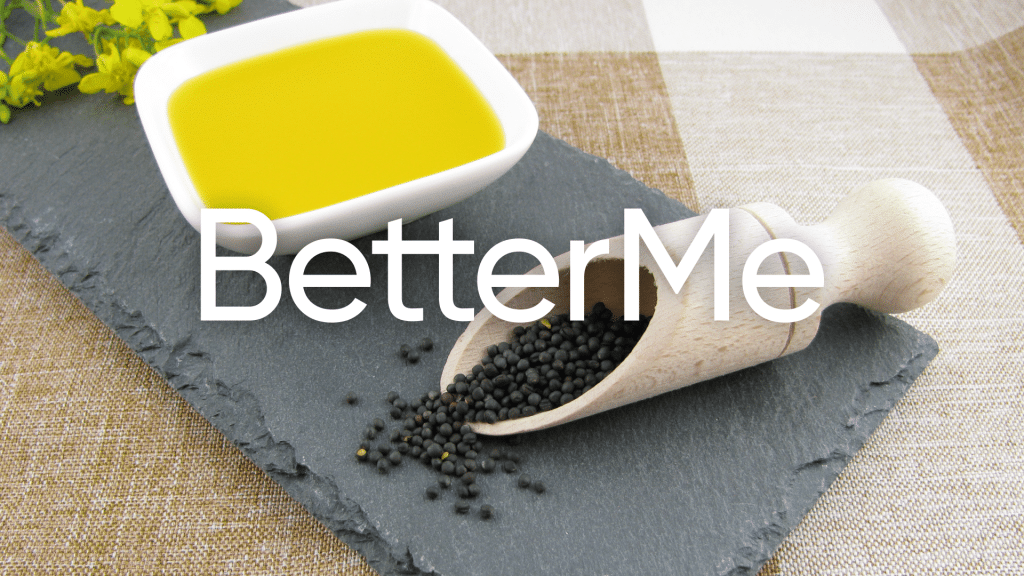As far as cooking oils go, canola oil has been considered one of the healthier options. The American Heart Association even recommends it as a good substitute for butter and other saturated fats. The oil is a popular ingredient in commercial food products, and can be found in baked goods, salad dressings, mayonnaise, and margarine. There are plenty of health benefits associated with consuming canola oil, which we’ll go over in this article. First, we’ll go over some basic nutrition facts and common uses. Then we’ll explore the potential side effects of canola oil, compared to other cooking oils such as olive oil and coconut oil.
Get your personalized
meal plan!
Nutrition Facts
Here’s a quick nutritional breakdown for one tablespoon of canola oil (2):
- Calories: 124
- Fat: 14g
- Sodium: 0mg
- Carbohydrates: 0g
- Fiber: 0g
- Sugars: 0g
- Protein: 0g
Canola Oil Calories
1 tablespoon of canola oil has 124 calories. All of these calories come from fat. Please note, most of the fat is considered to be “good fat”.
Saturated Fat – 1 gram Per Tablespoon
A small percentage of the fats in canola oil are saturated fats. Saturated fats are typically solid at room temperature and have been linked to a number of health problems, such as heart disease (10).
Monounsaturated Fat – 1 gram Per Tablespoon
Most of the fat in canola oil is made up of monounsaturated fats. These are considered a healthier form of fat because they improve blood cholesterol levels and decrease your risk of heart disease (10).
Polyunsaturated Fat – 4 grams Per Tablespoon
A decent percentage of the fat in canola oil is polyunsaturated fat, which has been shown to improve blood cholesterol levels as well as help prevent heart disease. Polyunsaturated fats include the essential omega-3 fats and omega-6 fats (9).
Trans Fat – 0 Grams Per Tablespoon
There are no trans fats in pure canola oil. Trans fat is considered the worst type for your health because it increases LDL cholesterol levels (the bad kind) while at the same time decreasing HDL cholesterol levels (the good kind) (9).
By consuming canola oil, you could get a decent amount of various types of healthy fats.
Read More: Canola Oil Vs Olive Oil: Which Is Healthier?
Canola Oil Health Benefits
The fats in canola oil offer a number of health benefits, including:
Heart Health
Canola oil has a good ratio of omega-6 fatty acids (linoleic acid) to omega-3 (alpha-linolenic) fatty acids. Consuming a good balance of these fatty acids has been shown to reduce the risk of heart disease and improve the condition of your blood vessels. Canola oil also contains high amounts of monounsaturated fat, which has been linked to lower cholesterol levels and improved heart health (7).
Improved Eye Health
Canola oil has omega-3 and omega-6 fatty acids, which are both nutrients that are good for your eyes. They make up the outer membrane of your eye, called the retina. Consuming enough of them can help protect against age-related macular degeneration which is the leading cause of blindness in older adults (6).
ImprovedBlood Lipid Levels
The fatty acids in canola oil help maintain healthy levels of triglycerides in the blood, boosting heart health even more. By replacing foods high in saturated fat with foods containing canola oil, you might reduce your triglyceride levels, improving your blood lipid profile (9).
Reduced Inflammation
Omega-3 fatty acids help reduce inflammation throughout the body. Chronic inflammation is associated with a number of diseases, including heart disease and diabetes (8).
As we mentioned earlier, those with Alzheimer’s tend to have low levels of DHA (docosahexaenoic acid), an omega-3 fatty acid. DHA is the main structural component of brain cells and studies have shown that people with Alzheimer’s tend to have less DHA in their system. When you consume canola oil, you could increase your intake of monounsaturated fat as well as omega-3 fats that can be converted to DHA by the body, which all help maintain your brain cells (3).
Canola Oil Side Effects
Though canola oil has plenty of health benefits, it has certain potential side effects worth noting:
GMO Concerns
Most canola oil on the market is made with genetically modified seeds. If you’re looking to avoid GMOs, it’s important to be aware of what you’re eating and purchasing. Organic and non-GMO canola oils are available on the market, but they’re a bit pricey.
Blood Thinner Concerns
While taking canola oil has been shown to improve blood cholesterol levels and lower LDL cholesterol, it does have an effect on blood thinning as well. Consuming foods high in omega-3 fatty acids like canola oil may prolong bleeding and increase your risk of bruising. Those who are scheduled to undergo surgery should avoid consuming canola oil or any foods rich in omega-3 fatty acids, two weeks prior to the procedure or as directed by their doctor (5).
If you’re taking blood thinning medications like Warfarin (Coumadin), it’s important to speak with your doctor before adding canola oil, or any foods high in omega-3 fatty acids to your diet.
Allergies
Because there is no protein in canola oil, reports of allergic reactions are rare.
Intense sweat sessions, working weight loss tips, lip-smacking recipes come in one package with the BetterMe app. And all of it is at your fingertips, start transforming your life now!
How To Use Canola Oil
The smoke point of canola oil is about 468-475°F (200°C), making it easier to cook foods at relatively high heat. Some of the ways you can use this oil include:
Shallow Or Deep Frying
Canola oil can also be used when deep frying foods. Because it has a high smoke point, you can use it to cook foods without worrying about them burning or getting ruined from the heat.
Sauteing And Stir Frying
Like when deep frying, sauteing or stir frying foods can also be done with canola oil. Because it has a neutral flavor, it won’t affect the taste of your food like other oils might.
On top of that, you don’t need to use much when cooking; just add in enough to coat your pan or skillet.
Salad Dressings And Marinades
When used in salad dressings and marinades, canola oil adds a creamy texture with a subtle nutty flavor. It also helps to tenderize meats while adding flavor.
Baking
You can also use canola oil in baked goods, especially if you’re looking to cut down on saturated fat. Because it has a mild flavor, it won’t alter the taste of your recipe. Plus, studies have shown that replacing butter with canola oil helps reduce calories without sacrificing texture or taste.
Read More: Canola Oil Vs Vegetable Oil Facts, Calories, Health Benefits And Side Effects
Canola Oil Recipes
Now that you know the benefits and potential risks, we’ll show you how to incorporate this oil into your cooking and recipes:
In Easy Chicken Curry (4)
Weeknight cooking doesn’t get any simpler than this 30-minute curry. It delivers a savory yet spicy flavor that will leave you satiated throughout the night. Here’s how you make it:
Ingredients:
- 2 tablespoons canola oil
- 2 large onions, peeled and sliced
- Salt and freshly ground black pepper to taste
- 2 teaspoons curry powder
- 1 can unsweetened coconut milk (1 1/2 to 2 cups)
- 1 1/2 pound peeled shrimp or boneless chicken, cut into 3/4 to 1 inch chunks
- 1 cup peeled, seeded and diced tomato (preferably canned, cut up and drain before using)
- Chopped basil or mint for garnish (optional)
Instructions:
- Start by placing the oil in a large skillet then set the heat to medium-high.
- Add in the onions alongside a sizable pinch of salt and some pepper about a minute later. Cook and stir occasionally for about 15 minutes or more, until the onions are falling apart and become very soft. Stir in the curry powder and cook for an extra minute while stirring.
- Add in the coconut milk and cook while stirring occasionally for about 2 minutes until it thickens.
- Add the chicken and stir, then continue cooking for 3 to 6 minutes before adding the tomatoes. Cook for one more minute and adjust the seasoning as desired.
- Serve over rice, garnished with mint or basil if desired.
This recipe is courtesy of nytimes.com
BetterMe app is a foolproof way to go from zero to a weight loss hero in a safe and sustainable way! What are you waiting for? Start transforming your body now!
In Beef And Mushroom Soup (1)
Looking for something quick for that chilly night? This hearty and chunky is just what you need. The canola oil and lean beef ensures the saturated fats are kept to a minimum, protecting your heart without compromising on taste! Here’s how you make it:
Ingredients:
- 1 Ib (454 g) extra lean ground beef
- 1 tablespoon canola oil (15 ml)
- 2 packages (8 oz each) sliced mushrooms
- 1 carrot, chopped
- 1 celery, chopped
- 1 onion, chopped
- 4 cloves garlic, minced
- 1 tablespoon Italian seasoning (15 ml)
- 1 teaspoon chili powder (5 ml)
- 1/4 teaspoon hot pepper flakes (1 ml)
- 1 tablespoon worcestershire sauce (15 ml)
- 6 cups reduced sodium or no-salt beef broth (1.5 L)
- 1 package (5 oz) baby spinach, chopped
Instructions:
- Place the beef in a soup pot and brown it over medium-heat and remove. Scrape the meat and drain into a colander and set aside.
- Return the pot to the meat before adding in the oil. Next add the carrot, mushrooms, onion, celery, garlic, hot pepper flakes and Italian. Cook and stir for about 15 minutes or until softened. Add the worcestershire and beef and continue stirring until it’s well combined.
- Next, pour in the squash and broth before bringing it to a boil. Turn down the heat, cover and let it simmer for about 15 minutes or until the squash is just tender.
- Remove the lid and stir in the spinach and cook for 3 more minutes or until it’s wilted.
- Ladle in deep bowls and serve hot.
This recipe is courtesy of canolainfo.org
The Bottom Line
Canola oil is a nutritious, flavorful oil made from a certain variety of rapeseed. It’s high in monounsaturated fat and may help you increase your intake of omega-3 fatty acids to maintain cell health and brain function.
In addition to possibly providing immense health benefits, canola oil is low in saturated fat and has a high smoke point, making it an option for when cooking at high heat.
DISCLAIMER:
This article is intended for general informational purposes only and does not serve to address individual circumstances. It is not a substitute for professional advice or help and should not be relied on for making any kind of decision-making. Any action taken as a direct or indirect result of the information in this article is entirely at your own risk and is your sole responsibility.
BetterMe, its content staff, and its medical advisors accept no responsibility for inaccuracies, errors, misstatements, inconsistencies, or omissions and specifically disclaim any liability, loss or risk, personal, professional or otherwise, which may be incurred as a consequence, directly or indirectly, of the use and/or application of any content.
You should always seek the advice of your physician or other qualified health provider with any questions you may have regarding a medical condition or your specific situation. Never disregard professional medical advice or delay seeking it because of BetterMe content. If you suspect or think you may have a medical emergency, call your doctor.
SOURCES:
- Beef and Mushroom Soup (n.d., canolainfo.org)
- Canola Oil (2020,usda.gov)
- Docosahexaenoic Acid Supplementation and Cognitive Decline in Alzheimer Disease (2012, nih.gov)
- Easy Chicken Curry (n.d., nytimes.com)
- Importance of maintaining a low omega-6/omega-3 ratio for reducing platelet aggregation, coagulation and thrombosis (2019, nih.gov)
- Omega-3 Fatty Acids and Eye Health: Opinions and Self-Reported Practice Behaviours of Optometrists in Australia and New Zealand (2020, nih.gov)
- Omega-3 Fatty Acids and Heart Health (2015, ahajournals.com)
- Omega-3 Fatty Acids and Inflammatory Processes (2010, nih.gov)
- The truth about fats: the good, the bad, and the in-between (2019, harvard.edu)
- Unsaturated Fats, High-Quality Carbs Lower Risk of Heart Disease (2015, acc.org)












